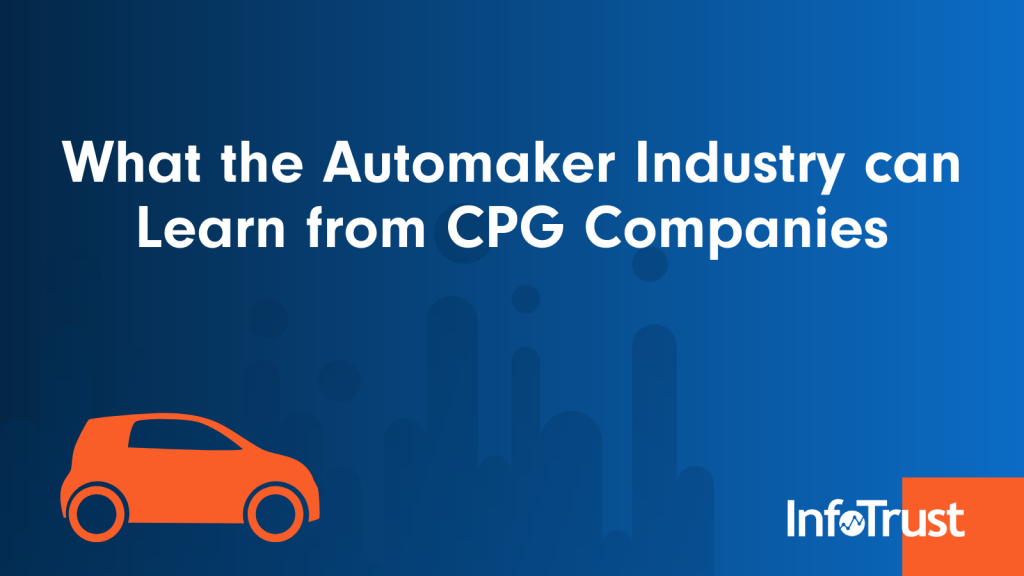Diapers, coffee, and frozen pizza are probably not the topics being discussed in the board rooms at the big car makers in 2021. But if the Original Equipment Manufacturers (OEMs) want to better understand the customer journey, maybe they should be.
The makers of the products I reference above are multi-brand, consumer packaged goods companies. They typically have dozens, if not hundreds, of brands which they sell in different markets across the United States and around the globe. As a result, each multi-brand enterprise could (and often does) have thousands of web properties, each one collecting valuable information. This is not unlike the auto industry which has thousands of digital assets across Tier 1 OEM sites to Tier 3 dealer sites.
As Google notes in their Dealer Guidebook 2.5, “83% of car purchasers spent up to three months doing research and are ready to buy when they arrive at your door. You can’t win on the showroom floor if you don’t first win online.” This statement underscores the importance of understanding the car shoppers’ behavior during that research phase.
Chris Vaughan, my friend and colleague who leads the CPG and multi-brand vertical at InfoTrust, pointed out some additional similarities that automakers share with CPG companies:
- No 360-degree view of the Customer Journey – Because the typical customer journey spans multiple digital assets owned by different parties, it has traditionally been difficult for key auto stakeholders to get a comprehensive, 360-degree view of the entire customer journey. The OEM has their brand site and each dealer has at least one website (not to mention the numerous 3rd party shopping sites that consumers use to inform their vehicle purchase). As a result, business decisions are often based on fragmented data that only tell a piece of the entire story.
- Siloed and decentralized tiers – The decentralized nature of marketing and analytics across the automaker tiers means that each tier manages their own strategy. Tier 1 usually focuses on branded efforts to drive awareness and consideration, with the Local Marketing Associations (Tier 2) and Dealer (Tier 3) usually focused on lower funnel activities. This fragmented network of assets makes it incredibly difficult to assess the collective performance of digital assets.
- Inconsistent measurement of business-critical KPIs – Due to a vast number of digital assets, it’s incredibly difficult to deploy a standardized data collection model across all of the websites/apps operated by OEMs, regional marketing associations, and their vast dealer networks. This leads to “gaps” in data collection which ultimately prevents organizations from using a data-driven approach for assessing the performance of websites/apps and marketing campaigns.
- Digital assets are “undervalued” by organizational leadership – Since the majority of automaker sales still take place offline, many leaders in these large, global organizations have difficulty quantifying the value their digital assets bring to their organizations.
These challenges cause many auto brands to remain “stuck” in a nascent state of the Analytics Maturity Framework where they are unable to maximize the impact and value of their digital marketing campaigns across media platforms like Google’s Display & Video 360 and Search Ads 360.
There is a blueprint that can handle these challenges and help establish a comprehensive data collection strategy. This helps form a clearer view of the customer journey so more informed marketing decisions can be made. These blueprint elements, used by multi-brand organizations in the CPG space, enable the foundational elements of a data-driven relationship between analytics and marketing.
1. A Holistic Global Data Layer Strategy
A global data layer strategy is designed to help collect more advanced data about digital assets across all brands, markets, etc. A data layer strategy allows enterprises to compile more insights and develop remarketing audiences for more impactful marketing efforts.
2. A Global Digital Analytics Architecture Strategy
The architecture needs to be tailored for both working in enterprise as well as to the specific needs of the individual auto manufacturers. It also needs to be designed to maximize the benefits of cross-brand remarketing and attribution in Google Analytics and beyond.
3. Comprehensive GA + GTM Configuration Standards
Configuration standards are designed to help enterprises establish a common “baseline” deployment of tools across all organizational digital assets. This should maximize the functionalities and benefits of GA360 and the Google Marketing Platform.
While this all sounds great in theory, what does it look like in action? InfoTrust has helped develop a comprehensive Global Data Framework and architecture for providing (and implementing) an analytics strategy. This strategy now fuels advanced data collection across thousands of digital assets around the world for major CPG organizations.
Enterprises that embrace this strategy have not only streamlined the Google Analytics architecture (which can involve removing thousands of GA properties from a company’s portfolio and leveraging APIs critical to scaled solution), but they also established market-based GA accounts. This allows individual markets to take advantage of cross-brand remarketing and attribution opportunities that were not previously available.
Imagine you are an automaker marketer with the opportunity to see how your national advertising campaigns impacted activity at the market or dealer level in a single analytics view. Or imagine you are a regional marketer with the ability to promote highly relevant offers to the most qualified audiences based on their online behavior. Sounds useful, right?
With large investments in programmatically purchased media, auto companies stand to benefit immensely from the data-driven relationship between analytics and marketing, arguably as much as (if not more than) multi-brand CPG enterprises. As OEMs and their vast network of dealers continue to adopt components of the Google Marketing Platform (including Campaign Manager, SA360 and DV360, and GA), there is an incredible opportunity to achieve a 360-degree view of their customer journey.


